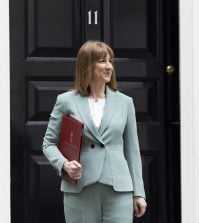Boris Johnson rose to power thanks to Theresa May’s Brexit errors; now he’s replicating them

Boris Johnson became the UK’s prime minister by attacking Theresa May’s approach to Brexit. But Johnson has already made exactly the same mistakes as his predecessor – so if he is re-elected in December, the next phase of Brexit will be just as tortuous, chaotic and rancorous as the last. By Matt Ross
The UK’s population is famously split over Brexit, but on one thing the vast majority would agree: the last 42 months have been an agonising period of chaos, deadlock and incompetence. Ask who’s to blame, and opinions split again. Yet there is now broad consensus that a couple of strategic errors, made by Theresa May soon after she became prime minister in July 2016, created the conditions for endless parliamentary squabbling, a series of defeats in EU negotiations, and repeated delays to the government’s exit plans.
Today’s prime minister Boris Johnson, currently in campaign mode as we approach the 12 December general election, has consistently criticised May’s approach to Brexit. But he appears to be falling into exactly the same traps: baked into his position lie strategic errors that are eerily close to those made by May. Assuming he wins the election, it’s possible that trying the same thing again will produce a different result the second time around. But in the battle between hope and experience, experience has so far proved a better forecaster at every turn in the Brexit road.
So, what does experience tell us – given the trade talks process, the negotiating partners’ interests, and Johnson’s Brexit policies – about how the relationship between the UK and EU is likely to pan out over the coming months and years? The key to Johnson’s prospects lies in May’s experiences – and in her mistakes, now being so carefully replicated by her successor.
Red lines and deadlines
First, in autumn 2016 May set out her “red lines” – effectively blocking any prospect of a close trading relationship with the EU by ruling out continued free movement, EU contributions, or the jurisdiction of the European Court of Justice. Leave campaigners had argued that EU nations, in order to maintain their healthy trade surplus with the UK, would bend Single Market rules to give Britain the freedoms it sought while maintaining frictionless trade.
But Brexiteers had exaggerated the UK’s bargaining power, failed to understand EU member states’ commitment to the integrity of the European project, and ignored the implications of her position for Ireland – where the creation of a trade border risked contravening the Good Friday Agreement. Chris Wilkins, May’s speechwriter at the time, has since acknowledged that the setting out of these red lines – designed to win support among Brexiteer MPs – “wasn’t done on the basis of a great deal of evidence. It was done on the basis that this was something we had to say.”
At the time, he added, all the Brexiteers’ rhetoric was “about how easy it was going to be. She was being told: ‘This isn’t going to be that complicated’.” But as it turned out, it was that complicated – and May’s red lines dramatically curtailed her freedom of manoeuvre as the negotiations got underway.

would give the EU’s 27 remaining member states “the upper hand”.
Second, May created deadlines that would later put her government under enormous pressure and hugely weaken its bargaining power. In January 2017, she pledged to leave the EU by March 2019 – whether or not a deal had been agreed – and argued that “no deal is better than a bad deal”. As she soon came to understand, this was not true: any deal would entail smaller trading and administrative barriers than those that accompany a no deal exit. But the promise raised hard Brexiteers’ expectations, and would result in a painful clash with elements of her own party.
Worse, in March 2017 she triggered Article 50 (A50), lighting the touchpaper on a two-year process that would – unless the EU agreed an exit deal or granted an extension – culminate in a no deal exit. And crucially, she did so without building any kind of consensus around the kind of future trading arrangements that would best serve the country’s interests, or honestly discussing the trade-offs and compromises that would be required to secure a deal.
Compromises, concealed
The fact that there was no agreement among Brexiteers about Britain’s landing place was the consequence of a deliberate strategy by leading Leave campaigners, who recognised that setting out a plan would alienate large sections of their support. What final operating model could please both deregulating free marketeers, and anti-capitalist ‘Lexiteers’ who viewed the EU as a tool of big business? How could Brexit bring both cheaper food imports, and a better living for the country’s farmers? It could not: to win a majority in the referendum, Leave campaigners instead made mutually-incompatible promises to a host of interest groups. “Remainers were trying to lure us into a defensive position by asking us to outline a model for life outside the club,” recalled Vote Leave’s communications director Paul Stephenson in September 2016. “We refused to play their game, and stuck to broad principles.”
But as May embarked on negotiations, crystalising a particular form of Brexit, some of the compromises required to secure a deal came into view. Few of these concerned the future trading relationship: the EU insisted that detailed talks could only be held following the UK’s exit, and May kept her plans here deliberately vague. Nonetheless, the Tory party went into meltdown, with hard Brexiteers particularly furious at the large bill for settling financial commitments and the Northern Ireland ‘backstop’ arrangements.
The PM’s position became weaker still after she lost her majority in the disastrous 2017 general election, which strengthened hard Brexiteers’ and Northern Ireland unionists’ ability to block her deal. Meanwhile May’s own red lines – plus her imperious style – prevented her from softening her Brexit in order to win the support of Opposition MPs.
So Britain’s politics became paralysed. And all the time, the ticking clock increased the pressure on the UK – for a no deal exit would hurt Britain far more than any individual EU nation. May’s March 2019 deadline, intended as a show of strength, had fatally weakened her at the negotiating table.
For close observers, the nature of the A50 process had always been obvious. Interviewed before the referendum, the former UK Treasury solicitor Sir Paul Jenkins – now sadly deceased – told GGF that triggering Article 50 would “give all the others, the 27 [remaining members] the upper hand: they can just say ‘no, no, no’ and walk away.” And Matthew Elliott, Vote Leave’s chief executive, told Politico in March that the A50 notification was “deeply regrettable”, adding that his plan “was not to trigger Article 50 pre-emptively, but to instead use the time after the referendum to prepare and plan.” Others have since caught up: Katie Perrior, May’s director of communications at the time, has acknowledged that the government “should have taken much more time at the beginning to trigger Article 50 and taken things much more slowly”.

Too late: the pattern had been set. May’s red lines, defining a hard Brexit, ruled out a cross-party solution. Conflicts among Leavers over what represents an acceptable Brexit ruled out May’s deal. And each time May approached exit day, the brutal consequences of no deal led her to pull back from the brink at the last minute: in March and April, she secured extensions from the EU. After Johnson came to power in October, the House of Commons – fearing that he might, deliberately or accidentally, take Britain over the cliff – required him to seek another, running to 31 January 2020.
Johnson repeats the errors
So now the UK is approaching election day – and, with the Tories polling between seven and 19 points ahead of Labour, it looks likely that Johnson will secure a majority. His manifesto includes a commitment to lay the Withdrawal Agreement (WA) before Parliament before Christmas, promising that “we will leave the European Union in January.” The WA allows for negotiations on the future trading relationship to run to 31 December 2020, while Britain remains inside the Single Market. At the end of this ‘implementation period’, the UK will either enter into an agreed trading relationship, or exit the Single Market without a trade deal.
The WA includes a further provision permitting the UK to extend the implementation period until the end of 2022, as long as it requests the extension by 31 July 2020 (no further extensions would be possible without rewriting the WA, which requires the approval of both the UK and European parliaments). But Johnson’s manifesto explicitly rules out an extension, stating bluntly that “we will not extend the implementation period beyond December 2020.” Restating May’s red lines, the manifesto also adds a new one – promising to keep the UK “out of any form of customs union”. And on the nature of the government’s negotiating goals and its preferred future trading relationship, it is almost silent: its sole relevant comment is a pledge to “ensure we are in full control of our fishing waters.”
This lack of honesty and transparency is setting the government up for a fall, a group of 14 trade experts warned this week: “The engines are being revved towards striking new FTAs by arbitrary deadlines, with little sense of what we actually want to achieve,” they wrote. The lack of open, realistic debate over the choices facing Britain “means worse policy, a degradation of public trust, and an undermining of support for any future deals before they are even negotiated,” said David Tinline, formerly a senior adviser to the WTO director general.
So Johnson has set himself some very tight timescales – both politically, and enshrined in an international treaty – that end in a very perilous cliff-edge: exiting the Single Market without a trade deal would impose huge costs on British exporters. He has constrained his freedom of manoeuvre in the talks within some very constrictive red lines. And he has made no attempt to build consensus around a particular model for post-exit trade, or to explain the trade-offs that will be required to agree a deal. Sound familiar?
Trading compromises

Johnson’s first deadline – that of leaving the EU by 31 January – may be deliverable, former Cabinet secretary Lord O’Donnell tells Global Government Forum. “But that’s just the end of the beginning,” he says. “We then get onto the hard slog of the trade relationship”.
And how will those negotiations pan out? Brexiteers claim that, because UK regulations and standards are currently aligned with the EU’s, the talks will be straightforward. But Ivan Rogers, the UK’s permanent representative to the EU until 2017, warned in a speech this week that “this is completely to misunderstand the process and the legal consequences of leaving”. The further the UK wishes to diverge from EU rules, he explained, the more complex the negotiations – and “the publicly avowed Johnson intention is to be much more distant from the EU” than May had planned. The former PM’s plan, Rogers added, was viewed as “wholly unacceptable” by hard Brexiteers precisely because it envisaged a relatively close alignment between the two markets; Johnson’s, by contrast, “liberates us to diverge much more radically.”
So the task facing negotiators will not be that of agreeing specific alterations to the existing rules; they will instead be beginning from scratch, building a ‘thin’ agreement that leaves the UK free to meet other countries’ demands as it works to broker trade agreements around the world. And the EU, Rogers explained, believes that after Brexit Johnson intends to lower UK regulatory standards in fields such as environmental protection, labour rights and consumer safety: it will take great care to ensure that any trade deal protects the ‘level playing field’, preventing the UK from attaining any competitive advantage by relaxing these rules.
Johnson’s position has clear implications for some sectors of British business – and as these become clear, we can expect the howls of protest to begin. For example, the manifesto pledges a “points-based immigration system”, touted by ministers as giving EU citizens no special rights. “The inevitable EU response is the termination of the obviously linked free movement of services, plus the ending of the current arrangements for the mutual recognition of professional qualifications,” comments Rogers, adding that the EU will also tightly regulate UK business in fields such as data management and financial services.
Johnson’s government has refused to publish an impact assessment of its plans. But research by think tank the Centre for European Reform suggests that in financial services alone, under this scenario UK businesses – which currently export £23.6bn (US$30.5bn) to the EU – could see their export revenues fall by 59%.
On goods, the EU is likely to agree a ‘zero tariffs, zero quotas’ deal that avoids direct taxes or strict limits on goods crossing the border – but in many fields, Rogers said, UK exporters may have to find an EU-based partner willing to confirm that British goods meet EU standards. They will also be subject to two separate regulatory regimes – increasing the costs of compliance – and, UK Trade Policy Project director David Henig explained this week, may still fall foul of tariffs regimes if they can’t satisfy ‘rules of origin’ conditions.
The wild cards
Clearly, these talks may have as their aim the creation of a ‘free trade agreement’ (FTA), but UK/EU trade will be far less free than it is now: as negotiations proceed, we can expect to see UK industries pushing hard for government to prioritise their concerns. And meanwhile, the talks will be buffeted by the disparate interests of 27 EU nations; for while the WA only required ratification by the European Parliament, the trade agreement will require the approval of every national parliament – and some regional ones too.
Before entering talks, the European Commission will agree a common negotiating position; but as the deadline approaches, individual member states could hold the whole process to ransom – insisting, as time pressure reaches a peak, that the UK accept their demands or see the talks fail. “There’s the possibility of the Commission negotiating in good faith, and then one of the parliaments saying: ‘No, unless you give this’,” comments O’Donnell. Nodding to the UK’s Brexit experience to date, he adds: “There would be a certain irony in a deal being negotiated, then a parliament saying: ‘No!’”

Faced with the conflicting demands of British industries and European nations, Johnson will have – finally – to prioritise: to decide where to use his leverage in talks, and where to give way to EU demands. The EU’s eight states with substantial fishing fleets will, for example, demand access to UK seas – creating a direct clash with Johnson’s promise to regain “full control of our fishing waters”. Yet 70% of seafood exports go to the EU: Johnson will have to drop his pledge, see the EU shut off export markets, or give substantial ground elsewhere – and how much political capital will he expend protecting a sector that represents 0.1% of the economy? Agriculture too looks intensely vulnerable, for the EU guards its farmers with tight regulatory standards and high food tariffs.
As these compromises and trade-offs emerge – and we learn which industries will take the hardest kicking under the new arrangements – we’ll once again hear calls of ‘betrayal’, with hard Brexiteers accusing the EU of bullying and calling for a ‘clean break’. And the nascent deal will indeed fall far short of the promises made by Johnson: “The price of level playing field conditionality and a fisheries deal will be very steep, and both will be very hard to swallow for the wing of the party that put [Johnson] into the premiership,” said Rogers, adding that the PM will face “a binary choice between a highly asymmetric, thin deal on [the EU’s] terms, and no deal”. But Johnson will be trapped – as was his predecessor – by his decision to set a hard deadline without first building agreement around a realistic set of priorities and goals.
History repeats itself
Johnson’s sole substantive advantages over May – assuming he wins a decent majority – will comprise his winner’s glow in the election’s aftermath, and his greater strength in the Commons. So if his victory is great enough, he may be able to blur his red lines without forfeiting his majority. And O’Donnell points out, “there are lots of hardline Brexiteers whose seats are at risk. It might be that the post-election Conservative [parliamentary] party is rather less hardline.”
Johnson had better hope so – for given the complexity of the talks, the host of competing EU national and UK business interests, and the inevitable opposition from ‘betrayed’ Brexiteers, there is zero prospect of a trade deal being agreed by the end of 2020. “A serious, wide coverage FTA cannot and will not get done in that time. And I know no one the other side of the Channel who thinks otherwise,” said Rogers; Henig and O’Donnell concur. Come July, it will be clear inside Number 10 that no remotely advantageous trade deal can be completed by the year’s end; with all the time pressures working against Britain’s interests, UK negotiators will be pressing for an extension.

UK will exit the ‘implementation period’ with no deal at the end of 2020.
In O’Donnell’s view, Johnson will at that point swallow his manifesto pledge and push the deadline on to 2022. “I’d put money on us wanting to extend,” he says, commenting that Johnson will be “thinking long-term about how to get the right answers to help his re-election” in the 2024 general election. And the PM is no stranger to U-turns, he notes, recalling his abandoned promises not to seek an extension in October: “Boris has said ‘no ifs, no buts’, ‘die in a ditch’, then not done it,” he says. “I don’t think anyone will regard anything in the manifesto as inevitably going to happen. And the pressures from businesses to get it right will be quite intense.”
Peter Foster, the Telegraph’s Europe editor, also believes the PM will seek an extension. “I think Johnson is a bottler, judging by what happened in October,” he tweeted this week. “He’s got no appetite for ‘no deal’… he may have no choice, he’s so boxed in, but he pivoted last time.”
Rogers, though, fears that the UK will exit the ‘implementation period’ with no deal at the end of 2020. And the fact that the UK is required to request an extension six months before the deadline will certainly make it difficult for Johnson to do so. On previous occasions, both May and Johnson insisted until the very last moment that they were sticking to their timetable, before folding days before the UK went over the cliff. With the cliff a safe-looking six months away, and the PM under pressure to stick to his Brexit pledges, putting in a request would show a level of foresight that neither Johnson nor his predecessor have displayed to date.
Even if talks do run to 2022 and a deal is agreed, O’Donnell believes that “a lot of the big issues will be left up in the air.” A full trade deal will, for example, require mechanisms to agree new rules as economies and products evolve: bodies to “constantly respond to changing marketplaces, consumer demand, technology; to say how we’re going to manage this kind of product, or this kind of data transfer.” It is possible that negotiations will plug all such gaps – but in view of how much progress talks have made over the last 2.5 years, the chances appear vanishingly small.
Onwards to the past
Johnson’s key message to the electorate is the plea to “get Brexit done”: the phrase appears 14 times in the manifesto’s first few pages. He knows that the British public are frustrated with Westminster’s stasis, and just want to put Brexit behind them. But the reality is that a Conservative victory on 12 December will simply move the country onto the next phase of Brexit – whilst closing off any retreat back into full membership. And the errors baked into Johnson’s strategy mean that the national debate accompanying trade talks will be as rancorous as anything we’ve seen to date.
Given a decent majority, Johnson will be less vulnerable to Parliamentary defeats than his predecessor. But where he sticks to his red lines, the trade barriers emerging out of talks will surprise and horrify businesses and communities across the country. Where he blurs them, hard Brexiteers will be outraged. And where talks bring into the open the compromises and trade-offs essential to finding agreement, the champions of a ‘cake and eat it’ Brexit will feel betrayed. The newly re-elected PM’s honeymoon period will fast deteriorate into a nasty domestic squabble.
So as the clock ticks down to zero hour – whether that’s in 2020 or 2022 – Johnson will find himself facing an agonising choice. He can seal a plainly disadvantageous deal, folding on key EU demands while maintaining some access to Britain’s biggest overseas markets. Or he can walk away, and seek to blame the ensuing recession on a recalcitrant European Union.
How Johnson responds to these dilemmas, we cannot yet know. But the deceptions and errors that make them inevitable are already plain for all to see.






















